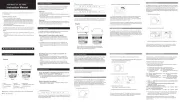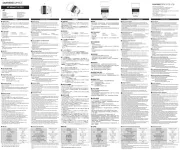
Please read this instruction manual prior to use.
Reflex 1:6.3 300mm ED UMC CS Lens
(Canon M, Fujifilm X, Sony E, MFT)
Thank you for purchasing the Reflex 1:6.3 300mm ED UMC CS lens.
We believe that you will have a special photographic experience with this new Reflex
1:6.3 300mm ED UMC CS lens.
With an optical design optimized for mirrorless cameras such as the Canon M,
Fujifilm X, Sony E and MFT, the Reflex 1:6.3 300mm ED UMC CS lens provides good
portability, a compact size, and an ability to produce various images from both close
up and long distance shooting.
The Reflex 1:6.3 300mm ED UMC CS lens is uniquely designed for Canon M, Fujifilm
X, Sony E and MFT cameras.
The Reflex 1:6.3 300mm ED UMC CS lens is a telephoto lens which uses a reflective
You can produce very interesting photos with this feature. This telephoto lens has a
long focal length, so it is very useful for shooting a still object from afar.
You can adjust the focus by turning the focusing ring when using the Reflex 1:6.3
300mm ED UMC CS lens, as it is a Manual Focus (MF) adjustment lens.
The Reflex 1:6.3 300mm ED UMC CS lens does not have an additional diaphragm,
so the brightness can be adjusted by using the ISO sensitivity and the shutter speed.
If the shutter speed is low, a moving subject cannot be captured successfully. Adjust
the sensitivity and exposure properly.
The hood has a bayonet system which guarantees speedy, efficient, safe and precise
installation, and enables you to enjoy shooting experience that is free from ghosting
Align the attachment reference point on the hood with the reference point on the lens.
Push the hood onto the lens and turn the hood to the right until it makes a clicking
The diaphragm of the Reflex 1:6.3 300mm ED UMC CS (Canon M, Fujifilm X, Sony
E, MFT) lens is not compatible with the camera.
Advantages of the Reflex 1:6.3 300mm ED UMC CS lens
1. A reflective system for APS-C (1:1.5x) mirrorless cameras
2. Through its premium optical design, it corrects aberrations and produces a high
resolution and high contrast at the center of the lens as well as around its
3. The lens hood and multi-coating design suppress flaring and ghost images.
4. Corrects aberrations and produces stable images with the low dispersion lens.
The Reflex 1:6.3 300mm ED UMC CS lens is uniquely designed for Canon M, Fujifilm
X, Sony E and MFT cameras. You can easily take photographs by mounting the lens
directly onto the camera, without installing an additional adaptor.
Read this manual carefully to familiarize yourself with your lens for correct use.
※ Please read the Safety Precautions at the back of this instruction manual prior to use.
1. Component Names 3. Focus Adjustment
9. Troubleshooting 10. Safety Precautions
2. Attaching and Detaching
① Mount Focusing ring Red ring④ ⑦
② ⑤ Distance scale indicator mark Hood
③ Focus scaling ring Hood locking area ⑥
Hold the lens hood gently, and align the camera mount attachment point with the
camera locking reference point on the lens. Next, push the lens into the camera and
turn the lens gently until it makes a clicking sound, and the distance scale indicator
mark is positioned on the upper part of the camera.
Hold the lens hood gently, press the lens release button on the camera, and turn the
lens in the opposite direction of the attaching direction to detach the lens.
① To change the focus from a subject that is far away to a subject that is close,
turn the focusing ring to the left (∞ to 0.9 m) and focus on the clearest subject
by using the indication signal on the camera, or through the LCD.
② To change the focus from a subject that is close to a subject that is far away,
turn the focusing ring to the left (0.9 m to ∞) and focus on the clearest subject
by using the indication signal on the camera, or through the LCD.
Canon M, Fujifilm X, Sony E, MFT Mount
1) Set the exposure to manual exposure (M) and change the focus mode to MF.
1) Turn the camera power on, and set the focus mode selector on the camera to M.
Using the command dial for partial magnification will make focusing easier.
2) Press the MENU/OK button, and select ON at 'Shoot without lens' in the
shooting menu. When the shooting mode is set to video recording, you need to
change the mode to still image capturing.
(The procedures above are for the Canon M. The settings for the camera or the menu may vary
based on the camera model or due to a functional upgrade. Refer to the camera instruction manual
or contact the camera manufacturer for detailed information.)
(The procedures above are for the X-Pro1. The settings for the camera or the menu may vary based
on the camera model or due to a functional upgrade. Refer to the camera instruction manual or
contact the camera manufacturer for detailed information.)
1) Set the camera mode dial to M.
2) Adjust the shutter speed by turning the dial to achieve the appropriate exposure
1) Set the camera mode dial to M.
2) Adjust the shutter speed by turning the dial to achieve the appropriate exposure for
(The procedures above are for the NEX-5. The settings for the camera or the menu may vary based
on the camera model or due to a functional upgrade. Refer to the camera instruction manual or
contact the camera manufacturer for detailed information.)
(The procedures above are for the E-P2. The settings for the camera or the menu may vary based
on the camera model or due to a functional upgrade. Refer to the camera manual or contact the
camera manufacturer for detailed information.)
※ For some Sony E cameras, if you set the camera mode dial to A and set the
brightness, the camera automatically changes the shutter speed. Therefore you
don't need to adjust the shutter speed as well, which is required in M mode.
※ For some Olympus (MFT) and Panasonic (MFT) cameras, if you set the camera
mode dial to A and set the brightness, the camera automatically changes the
shutter speed. Therefore you don't need to adjust the shutter speed as well, which
APS-C (1:1.5x) 5.4° (diagonal)
Four Thirds (4/3”) 4.2° (diagonal)
Number of groups 9 Groups
Issue Causes Corrective Action
A lens cannot be attached to
The attachment reference point on the
lens is not aligned with the lens
attachment reference point on the
Align the attachment reference point on the
lens with the lens attachment reference point
A lens cannot be detached
Incorrect rotation direction for
If you turn the lens while holding the
camera, it may cause damage to the
Press the lens release button on the camera,
and gently turn the lens to the lens
attaching/detaching reference points, in the
direction as marked on the camera, and then
Insufficient shutter speed or camera
Turn the focusing ring while checking a
magnified image in Live View, set the focus
until it becomes clear, and then press the
Steady the camera and take a photograph at a
shutter speed of 1/125 secs.
Automatic focusing does not
A manual focusing lens has trouble
Use the focusing ring to adjust the focus.
Dark or too bright pictures
Set the ISO sensitivity properly.
Set the shutter speed of the camera properly.
The manual control lens may not be
compatible, depending on the camera.
The camera finder indication
This lens does not have an electric
contact signal, so there is no
communication with the camera
through electric signals.
This lens is a single lens.
This lens cannot be mounted
This lens is designed for its own
Purchase the designated lens mount.
You want to attach our 2X or
Our converter is designed for the T
(M42 screw) mount only. Therefore it
cannot be used with this lens.
Use each company's own mount converter.
However, be aware that auto focusing is
Do not wet this product or expose it to a moist environment. It may cause a
Do not use this product or store it close to devices that generate heat i.e.,
heaters, thermal regulators, stoves or stereo amplifiers.
Do not leave the lens in conditions where drastic temperature changes can
Do not touch the surface of the lens by hand, and avoid making contact with
Do not soak the lens in water, and avoid water splashing onto the lens.
If there are foreign bodies on the lens, use a lens cleaning kit only.
If the lens hood is cut by the user, it may cause damage to the surface of the
lens, as the surface of the lens may make contact with the floor.
ensure the lens is held in place
properly; otherwise the lens may
become loose and cause an
Don't put excessive pressure
on the lens attached to the
cause damage to the lens or
to the camera mount. Be sure to
hold the lens when operating or
checking the lens beforehand or by
test shooting for important events
Don't leave the lens within
reach of babies, as it may
cause injury to the baby if the
lens falls or is dropped.
Don't attempt to modify or
alter the lens. It may lead
to failure of the camera. Modified
or altered lenses may not be
cause a fire, depending on
directly through a camera
with a lens attached. It may
If this instruction is not
followed, it may cause death
or severe injury to the user.
If this instruction is not
followed, it may cause death
or severe injury to the user.
The following precautions are divided into two types
according to the level of danger.
The following pictograms are used in the below precautions:
Requires caution. Inside the pictogram it shows contents of precautions.
(It shows outbreak of fire in the pictogram on the left.)
Shows prohibition. Inside the pictogram it shows contents of prohibition.
(It shows prohibition of dismantling in the pictogram on the left.)
Shows instruction. Inside the pictogram it shows contents of instructions.
(It shows instruction of precaution in the pictogram on the left.)




















